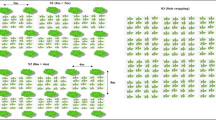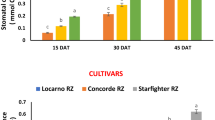Abstract
Reuse of treated wastewater is vital to increase green cover and bio-product and minimize environmental degradation. Seven tree species were planted and irrigated with borewell water at ½ET (Evapotranspiration, I1) and treated wastewater at ½ ET (I2), ¾ ET (I3), and 1ET (I4) to assess growth, productivity and efficient species in utilizing wastewater for more biomass. Wastewater was saline with high Na and low NH4-N, NO3-N and PO4-P. Irrigation from I2 to I4 enhanced (P < 0.05) height (6.7–11.1%), collar diameter (9.0–17.6%), crown diameter (14.7–20.8%) and total biomass (41.2–87.3%) over borewell water plants (I1). Increases in biomasses were greater in shoot (stem, branches and leaves) than roots reducing root-shoot ratio with plant age. Varying irrigation levels had no effects on shift in biomass allocation between components, but impact of species was significant with highest biomass allocation to stem in E. camaldulensis and A. indica, and branches in other species. Mean Annual Increments (MAIs) in growth and biomass were less in P. cineraria/T. aphylla, medium in Salvadora oleoides, E. camaldulensis and S. persica, and highest in A. indica and P. juliflora. Conclusively, indigenous P. cineraria, S. oleoides and S. persica along with T. aphylla tended to adapt wastewater irrigation by allocating greater biomass to roots. E. camaldulensis, A. indica and P. juliflora maximized root biomass to sustain above-ground productivity. S. persica, A. indica and P. juliflora were most efficient in utilizing treated wastewater and can be beneficially reused in afforestation, producing biomass for people and environmental amelioration in arid areas.




Similar content being viewed by others
Data and material availability
The data generated during this research work are available from the corresponding author upon request.
Abbreviations
- ET:
-
Evapo-transpiration
- RSR:
-
Root-shoot ratio
- MAI:
-
Mean annual increment
References
Ahmad T, Belwal T, Li L, Ramola S, Aadil RM, Abdullah XY, Zisheng L (2020) Utilization of wastewater from edible oil industry, turning waste into valuable products: a review. Trends Food Sci Tech 99:21–33
Ali HM, El-Mahrouk SM, Hassan FA, El-Tarawy MA (2011) Usage of sewage effluent in irrigation of some woody tree seedlings. Part 3: Swietenia mahagoni (L.) Jacq. Saudi J Biol Sci 18(2):201–207
Belaid N, Neel C, Kallel M, Ayoub T, Ayadi A, Baudu M (2010) Effects of treated wastewater irrigation on soil salinity and sodicity in Sfax (Tunisia): a case study. J Water Res 23:133–146
Bhandari MM (1990) Flora of the Indian desert. Scientific Publishers, Jodhpur
Bhati M, Singh G (2003) Growth and mineral accumulation in Eucalyptus camaldulensis seedlings irrigated with mixed industrial effluents. Bio Resource Technol 88(3):221–228
Chaganti VN, Ganjegunte G, Niu G, Ulery A, Flynn R, Enciso JM, Meki MN, Kiniry JR (2020) Effects of treated urban wastewater irrigation on bioenergy sorghum and soil quality. Agric Water Manag 228:105894
Chi J, Waldo S, Pressley SN, Russell ES, O’Keeffe PT, Pan WL, Lamb BK (2017) Effects of climatic conditions and management practices on agricultural carbon and water budgets in the inland Pacific Northwest USA. J Geophys Res Biogeosci 12:3142–3160
Coyle DR, Coleman MD (2005) Forest production responses to irrigation and fertilization are not explained by shift in allocation. For Ecol Manage 208:137–152
CPCB (2021) National inventory of sewage treatment plants. In: Central Pollution Control Board, Government of India
DalCorso G, Fasani E, Manara A, Visioli G, Furini A (2019) Heavy metal pollutions: state of art and innovation in phytoremediation. Int J Mol Sci 20:3412. https://doi.org/10.3390/ijms20143412
Damkjaer S (2020) Drivers of change in urban water and wastewater tariffs. H2Open J 3(1):355–372. https://doi.org/10.2166/h2oj.2020.031
Grogan J, Schulze M (2012) The impact of annual and seasonal rainfall patterns on growth and phenology of emergent tree species in Southeastern Amazonia, Brazil. Biotropica 44(3):331–340
Hardikar SA, Panchal NS, Pandey AN (2011) Growth, water status and nutrient accumulation of seedlings of Salvadora oleoides (Decne.) in response to soil salinity. Tropical Ecol 52(3):253–264
Hashem MS, Qi X (2021) Treated wastewater irrigation-a review. Water 13:1527. https://doi.org/10.3390/w13111527
Hayes WE, Walker LR, Powell EA (2009) Competitive abilities of Tamarix aphylla in Southern Nevada. Plant Ecol 202:159–167
IFC (2013) Rajasthan water assessment-potential for private sector intervention. In: International Finance Corporation, New Delhi. https://www.ifc.org/wps/wcm/connect/adb3a529-b75e-4dbc-89f1-c33df69e3d2e/Water+Assessment+and+Potential+for+Private+Sector+Interventions-Final.pdf?MOD=AJPERES&CVID=k0aFySX
IWA (2018) The reuse opportunity. In: Wastewater Report 2018. The International Water Association. https://www.iwa-network.org/wp-content/uploads/2018/02/OFID-Wastewater-report-2018.pdf. Accessed 16 Nov 2021
Jones ER, van Vliet MTH, Qadir M, Bierkens MFP (2021) Country-level and gridded estimates of wastewater production, collection, treatment and reuse. Earth Syst Sci Data 13:237–254
Khalid S, Shahid M, Natasha BI, Sarwar T, Shah AH, Niazi K (2018) A review of environmental contamination and health risk assessment of wastewater use for crop irrigation with a focus on low and high-income countries. Int J Environ Res Public Health 15(5):895. https://doi.org/10.3390/ijerph15050895
Kidd P, Mench M, Álvarez-López V, Bert V, Dimitriou L, Friesl-Hanl W, Herzig R, Janssen JO, Kolbas A, Müller I, Neu S, Renella G, Ruttens A, Vangronsveld J, Puschenreiter M (2015) Agronomic practices for improving gentle remediation of trace element-contaminated soils. Int J Phytoremed 17(11):1005–1037
King DA (1991) Correlations between biomass allocation, relative growth rate and light environments in tropical forest saplings. Funct Ecol 5:485–492
Kumar AY, Reddy MV (2010) Effects of municipal sewage on the growth performance of Casuarina equisetifolia (Forst.&Forst.)on sandy soil of east coast at Kalpakkam (Tamil Nadu, India). Appl Ecol Environ Res 8(1):77–85
Liu C, Liu F, Andersen MN, Wang G, Wu K, Zhao Q, Ye Z (2021) Domestic wastewater infiltration process in desert sandy soil and its irrigation prospect analysis. Ecotoxicol Environ Saf 208:111419. https://doi.org/10.1016/i.ecoenv.2020.111419.Epub
Maaloul A, Michalet S, Saadaoui E, Ghzel N, Bekir J, Romdhane CB, Mars M, Dijoux-Franca MG, Romdhane M (2019) Effect of treated wastewater on growth and secondary metabolites production of two Eucalyptus species. Agric Water Manage 211:1–9
Madejón P, Marañón T, Navarro-Fernández CM, Domínguez MT, Alegre JM, Robinson B et al (2017) Potential of Eucalyptus camaldulensis for phytostabilization and biomonitoring of trace-element contaminated soils. PLoS ONE 12(6):e0180240. https://doi.org/10.1371/journal.pone.0180240
Minhas PS, Saha JK, Dotaniya ML, Sarkar A, Saha M (2022) Wastewater irrigation in India: current status, impacts and response options. Sci Total Environ 808:152001. https://doi.org/10.1016/j.scitotenv.2021.152001
MoEF (2014) Central Pollution Control Board, Ministry of Environment and Forest, Government of India, New Delhi. https://cpcb.nic.in/displaypdf.php?id=SW5kdXN0cnktU3BlY2lmaWMtU3RhbmRhcmRzL0VmZmx1ZW50L0R5ZWFuZER5ZV9JbnRlcl9JbmR1cy5wZGY=. Accessed 22 Apr 2022
MoHUA (2020) Ministry of Housing and Urban Affairs, Government of India, Water Plus Protocol and Toolkit, India, Government of India. https://www.sbmurban.org/water-plus#:~:text=Water%20Plus%20Protocol%20and%20Toolkit,-Home%20/%20Water%20Plus&text=A%20city%20can%20be%20declared,treated%20wastewater%20to%20the%20environment
MoJS (2021) National framework on the safe reuse of treated water. In: Ministry of Jal Shakti, Department of Water Resources, River Development & Ganga Rejuvenation National Mission for Clean Ganga. 32_SRTW Framework_Final_23_11_2021 (1)
Mondal PK, Liu Y, Kateryna S, Zeng L, Hanhao A (2017) Water pollution situation and applied wastewater treatment strategies in Bangladesh. Int J Adv Res 5:2072–2083
Monteverdi MC, Da-Canal S, Del-Lungo A, Masi S, Larbi H, De-Angelis P (2014) Re-use of wastewater for a sustainable forest production and climate change mitigation under arid environments. Ann Silvicul Res 38:22–31
Morhart C, Sheppard JP, Schuler JK, Spiecker H (2016) Above-ground woody biomass allocation and within tree carbon and nutrient distribution of wild cherry (Prunus avium L.)—a case study. For Ecosyst 3:4. https://doi.org/10.1186/s40663-016-0063-x
Nasr M (2016) Utilization of treated wastewater and sewage sludge in forest ecosystems. For Res 5:e123. https://doi.org/10.4172/2168-9776.1000e12312
Nikore M, Mittal M (2021) Arresting India’s water crisis: the economic case for wastewater use. In: ORF Issue Brief No. 453, March 2021, Observer Research Foundation
Ofori S, Puškáčová A, Růžičková L, Wanner J (2020) Treated wastewater reuse for irrigation: pros and cons. Sci Total Environ 760:2021. https://doi.org/10.1016/j.scitotenv.2020.144026
OMA (1990) Official methods of analysis. 15th Edn. Association of official Analytical Chemists, Arlington, Virginia, USA
Poudel I, Cohen S, Shaviv A, Bar-Tal A, Bernstein N, Heuer B, Ephrath J (2016) Impact of treated wastewater on growth, respiration and hydraulic conductivity of citrus root systems in light and heavy soils. Tree Physiol 36(6):770–785
Raklami A, Tahiri AI, Bechtaoui N, Abdelhay E, Baslam M, Meddich A, Oufdou K (2021) Restoring the plant productivity of heavy metal contaminated soil using phosphate sludge, marble waste and beneficial microorganisms. J Environ Sci 99:221–221
Reis MM, da Silva AJ, Santos LDT, Lopes EMG, Barros RE, Donato LMS (2019) Millet irrigation with treated wastewater: gas exchange response and nutrient accumulation. Agric Sci. https://doi.org/10.1590/1413-7054201943023519
SGP (2016–2019) State Government Policies of Chhattisgarh (undated), Gujarat (2018), Haryana (2019 draft), Jammu and Kashmir (2017), Jharkand (2017), Karnataka (2017), Madhya Pradesh (2017), Maharashtra (2019 draft), Punjab (2019), Rajasthan (2016), Tamil Nadu (draft 2019), Uttar Pradesh (draft 2018)
Shiferaw H, Almirev T, Dzikiti S, Bewket W, Zeleke G, Schaffner U (2021) Water use of Prosopis juliflora and its impacts on catchment water budget and rural livelihoods in Afar Region, Ethiopia. Sci Rep 11:2688. https://doi.org/10.1038/s41598-021-81776-6
Singh AP (2018) Status report on CETPs, STPs and industrial pollution in Jojari River (Jodhpur to Balotra). Submitted in reference to Hon’ble National Green Tribunal (NGT), New Delhi. https://greentribunal.gov.in/sites/default/files/all_documents/Status_Report_filed_by_Dr._Ajit_Pratap_Singh_of_BITS_Pilani_in_Original_Application_No._329.pdf. Accessed 27 Sep 2021
Singh A, Agarwal M (2012) Effects of waste water irrigation on physical and biochemical characteristics of soil and metal partitioning in Beta vulgaris L. Agric Res 1:379–391
Singh G, Bhati M (2003) Mineral toxicity and physiological functions in tree seedlings irrigated with effluents of varying chemistry in sandy soil of dry region. J Environ Sci Health Part A 21:45–63
Singh G, Bhati M (2004) Soil and plant mineral composition and productivity of Acacia nilotica L. under irrigation with municipal effluent in an arid environment. Environ Conserv 31(4):1–8
Singh G, Bhati M (2005) Growth of Dalbergia sissoo in Desert regions of western India using municipal effluent and the consequent changes in soil and plant chemistry. Bio-Resourc Tech 96(9):1019–1028
Singh B, Singh G (2003) Biomass partitioning and gas exchange in Dalbergia sissoo seedlings under water stress. Photosynthetica 41(3):407–414
Singh G, Bhati M, Rathod TR (2010) Use of tree seedlings for phytoremediation of a municipal effluent used in dry areas of north-western India: plant growth and nutrient uptake. Ecol Eng 36:1299–1306
Singh G, Bhati M, Rathod TR, Tomar UK (2014) Physiological responses to nutrient accumulation in trees seedlings irrigated with municipal effluent in Indian desert. Physiol J 2014:545967. https://doi.org/10.1155/2014/545967
Ungureanu N, Vlădut V, Voicu G (2020) Water scarcity and wastewater reuse in crop irrigation. Sustainability 12:9055. https://doi.org/10.3390/su12219055
Wang H, Inukai Y, Yamauch A (2006) Root development and nutrient uptake. Crit Rev Plant Sci 25(3):279–301
Wu J, Hong J, Wang X, Sun J, Lu X, Fan J et al (2013) Biomass partitioning and its relationship with the environmental factors at the alpine steppe in northern Tibet. PLoS ONE 8(12):e81986. https://doi.org/10.1371/journal.pone.0081986
Yan A, Wang Y, Tan SN, Yusof MSM, Ghosh S, Chen Z (2020) Phytoremedation: a promising approach for revegetation of heavy metal-polluted land. Front Plant Sci 1:1. https://doi.org/10.3389/fpls.2020.00359
Acknowledgements
We wish to express our sincere thanks to the Director Arid Forest Research Institute, Jodhpur for providing the facilities to carry out research. We are also grateful to the State Forest Department, Government of Rajasthan, Jaipur for financial assistance and CAZRI, Jodhpur for providing meteorological data. We also thank independent reviewers for their suggestions for improvement of the manuscript.
Author information
Authors and Affiliations
Corresponding author
Ethics declarations
Conflict of interest
The authors declare that they have no known competing financial interests or personal relationships that could have appeared to influence this work.
Additional information
Publisher's Note
Springer Nature remains neutral with regard to jurisdictional claims in published maps and institutional affiliations.
Supplementary Information
Below is the link to the electronic supplementary material.
Rights and permissions
About this article
Cite this article
Singh, G., Nagora, P.R., Haksar, P. et al. Species influenced growth, biomass allocation and productivity in wastewater irrigated plants in sandy soils of Indian desert. Irrig Sci 40, 829–843 (2022). https://doi.org/10.1007/s00271-022-00809-8
Received:
Accepted:
Published:
Issue Date:
DOI: https://doi.org/10.1007/s00271-022-00809-8




